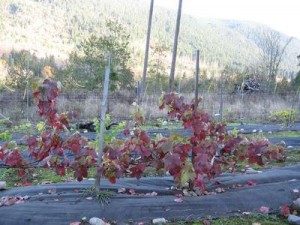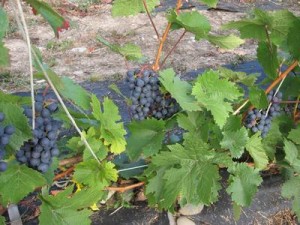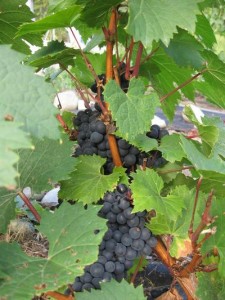‘You have captured the magic of the science, but neglect to mention the hard work involved as well. I used to work for Neuharth Winery in Sequim, and I was blessed to have known Romeo Conka from Lost Mountain winery. Both of these wineries bought in grapes from E. WA or OR.
Gerard from Bainbridge Vineyards insisted on producing wines from his own local vineyard … “the way it was meant to be done,” not with trucked in grapes or even more forbidden concentrate packages. He was quite an opinionated character. He and his wife JoAnne Bentryn retired and the management is in the capable hands of Betsey Wittick who could out prune and tie grape vines three to my own.
Working for a friend I was asked to establish a small vineyard for him at the top of Fish Hatchery Rd. I pleaded with him not to do it. Anyhow we proceeded with some 6 varietals that would do the best. Some were a total failure. I will give you an idea of the ‘work’ needed just to do 60 vines.
http://sequimplants.com/pruning-wine-grapes-cool-pacific-northwest
In posting this I realized that I had never made a page for the grape varietals we planted. Norwegian Muscat, Ortega, Regent, Dunkelfeder, Dornfelder
Pinot Gris, Madeleine Angevine, Muller Thurgau and Siegerrabe. All of these were supposed to be Low Grow Degree Day (1600 GDD) grape varietals.
Well, that location was not equal to Bainbridge Island and my favorite wines of that winery were Muller Thurgau and Madeline Angevine.
And if Betsey could out prune me, she and all these other winemakers just put my finished product into the rotgut category. See exception on the bottom.
White Wine Varietals
GERMAN:
Siegerrebe — A (Madeleine Angevine X Siegerrebe) cross. One of the earliest varieties to ripen. This variety makes an excellent fruity wine with spice and light fruit aromas. It has grown in Western WA for over 25 years and probably would be my first choice in any vineyard.
Muller Thurgau — is a white-blush wine that produces less fruit than most but is very vigorous vine and makes a deliciously sweet desert wine. Poundage of grapes per vine is less than most others.
FRENCH:
Madeleine Angevine. This variety makes a fruity white wine with citrus aroma and a note of apricots. It is productive but is susceptible to fruit rot. This grape variety needs intense watching as the grapes mature. If successful it is beyond belief!
Pinot Gris like Muller Thurgau is a less productive variety, but makes for a great white fruity spicy wine.
Rows of 8 plants per variety is a minimum to give you anything of a yield to produce some gallon-age. The best varieties can yield up to 20 lbs. per vine (depending on climate, site and choice of cultivar) the low end of the scale can be only FIVE pounds of grapes per vine. Hence Muller Thurgau is often bottled in beer sized bottles for the same price of others
REDS
Regent (Two years from now) A Sylvaner x with Mueller-Thurgau. This hybid tastes like a vinifera and is very disease resistant. Loose clusters make a very good red wine and its disease resistance makes this an ideal choice for the organic grower of for the home winemaker
Dornfelder A vigorous vine that may actually tend to overproduce. Clusters should be thinned out. Sugar levels tend to be low and acid levels can drop fast just prior to harvest. Another good grape to blend with others.
OTHERS
Ortega (Two years from now) An early ripening white wine grape with high sugar levels and low acidity. This is a very promising new hybrid and is a gross between Muller-Thurgau and Siegerrebe — both of are GREAT!
I must hasten to add that my attempts were not really swill, but they certainly didn’t measure up to my fruit wines. Link here and above.
Mind you I could never equal Waynes black cherry wines or ‘Newberry’ wine. Newberry was a local Raspberry cross by a local botanist in the 50’s. It has now all but disappeared.
Clallam County WA. grows great fruits and I often had beakers full of Shiro plum, Rhubarb, blackberry, currents, gooseberry burbling away. Both Wayne and I HOARDED any native Blackcap wine we were able to make.
The Newberry was very similar to a Loganberry and I never did get the full parentage. Another fruit waiting to be used is the Aronia berry a beautiful and useful landscape plant. Sadly, I have found the birds love this berry even more than blueberries. BTW, my gooseberry wine could have stood up to many of these blue ribber grape wines.
(C) Herb Senft 2008 edited 2014




